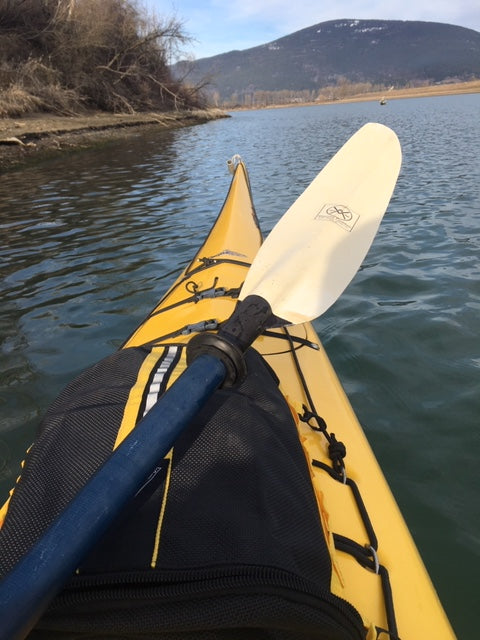
Inuit Kayak Paddle Design: What do they know?
Share
Watching a native repairing his traditional “skin on frame” kayak, I noticed the unique shape of his paddle. The long blades were not much wider than the shaft. I asked him about the design. Pausing, the Inuk looked around at the barren tundra of northern Baffin Island and quietly suggested “we are a long way north of the nearest tree.”

Archive photo Found on Pinterest
Contemplating his cryptic answer, I considered that the Inuit have historically used whatever they could find or salvage to look after their needs…this would include using any wood drifting up on their shores to fashion a paddle out of. In the absence of glues and epoxies, Small diameter trees and narrow boards would by default become narrow paddles. Expedient, but how practical are the narrow blades? I wondered that if given the opportunity of wider boards, would the long, narrow blade design have evolved?
The interesting thing is that my favorite paddle is a modern version of the Inuit design. Made by “Werner” paddles, the long, light weight shaft and the narrow blades make paddling long distances almost effortless.

Inuit design on the right
To delve deeper into the longer paddles with narrow blades versus shorter shafts and wider blades, we have to discuss paddling styles…. basically, high angle vs. low angle.
A high angle is where the stroke blade goes into the water close to the hull at a steep angle, and the off set blade goes quite high creating a “high angle” at the paddle shaft. The high angle style generally uses a shorter overall paddle length with shorter but wider blades. It is well suited for generating a powerful stroke….think power and speed. As a result, high angle paddling generally uses more energy. You can tell if you are using a high angle stroke if your upper hand consistently goes above your shoulder height.
By contrast, a low angle style uses a longer paddle, and in the case of the Inuit design, has elongated, narrower blades. As the stroke blade enters the water further away from the hull at a shallow angle, the offset blade does not have to be lifted as high by the paddler. This makes for considerably less energy required by the paddler. As well, the thinner, elongated blades dip at a lower angle into the water also requiring less energy. The interesting thing is that the actual total surface area of the Inuit style blade can be close to the same as the power stroke blade but due to the shape, does not create the same physical force. So the trade off is more, but easier strokes, for the same distance covered with the thinner blade.

Werner paddle based on Inuit Design
I have found that for long distance, multi-day expeditions, I tend to use the Inuit design paddle most of the time. As a back up paddle, I carry a shorter shafted, larger bladed paddle such as the Werner Camano. I instinctively use the Camano in larger seas and higher winds, or going against a tide or current – basically, when I need power or a wider blade for bracing.
Traditionally, the Inuit didn’t have the luxury of unlimited materials to make their paddles with so ended up with paddle blade widths dictated by the size of the wood they could salvage. That being said, the Inuit design works well for a low angle paddling style.
Adventure is where you find it.